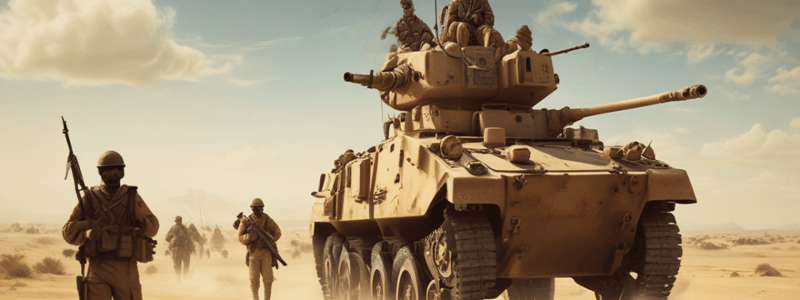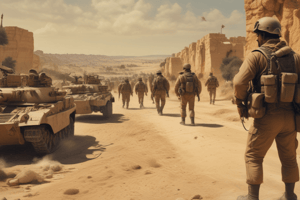Podcast
Questions and Answers
What anniversary was Israel celebrating when four Arab states moved troops to its borders?
What anniversary was Israel celebrating when four Arab states moved troops to its borders?
The nineteenth anniversary of Israel becoming a State
What was the grim resolution announced by Cairo Radio on May 25, 1967?
What was the grim resolution announced by Cairo Radio on May 25, 1967?
To wipe Israel off the world map
What was the significant advantage the Arab states had over Israel in terms of tanks?
What was the significant advantage the Arab states had over Israel in terms of tanks?
The Arab states had 2,504 tanks compared to Israel's 800
What was the ratio of combat aircraft between Israel and the Arab states?
What was the ratio of combat aircraft between Israel and the Arab states?
What was the motivation behind Israel's decision to strike first on June 6, 1967?
What was the motivation behind Israel's decision to strike first on June 6, 1967?
What was the outcome of the Israeli air force's strike on June 6, 1967?
What was the outcome of the Israeli air force's strike on June 6, 1967?
How long did the ground battle last during the Six-Day War?
How long did the ground battle last during the Six-Day War?
What event marked the end of the Six-Day War on June 10, 1967?
What event marked the end of the Six-Day War on June 10, 1967?
What territories did Israel capture from the neighboring countries during the war?
What territories did Israel capture from the neighboring countries during the war?
Why was Yerushalayim (Jerusalem) a divided city prior to the 1967 war?
Why was Yerushalayim (Jerusalem) a divided city prior to the 1967 war?
What was the significance of the Israeli forces' decision to enter the Old City and advance towards the Kotel?
What was the significance of the Israeli forces' decision to enter the Old City and advance towards the Kotel?
What do you think the photo of the Israeli paratroopers at the Kotel suggests about their feelings?
What do you think the photo of the Israeli paratroopers at the Kotel suggests about their feelings?
What is the symbolism of the shofar being blown in the context of Jerusalem's reunification?
What is the symbolism of the shofar being blown in the context of Jerusalem's reunification?
Why do you think Jerusalem is called 'The city of Gold'?
Why do you think Jerusalem is called 'The city of Gold'?
What was the significance of Rabbi Shlomo Goren leading the Mincha services at the Western Wall?
What was the significance of Rabbi Shlomo Goren leading the Mincha services at the Western Wall?
Why did Siggy Fried, a student from Brooklyn, travel to Israel in June 1967?
Why did Siggy Fried, a student from Brooklyn, travel to Israel in June 1967?
What significant change did the rabbi make to the traditional Jewish prayer during the liberation of Jerusalem?
What significant change did the rabbi make to the traditional Jewish prayer during the liberation of Jerusalem?
What was the significance of Israel returning the Sinai Peninsula to Egypt in 1982?
What was the significance of Israel returning the Sinai Peninsula to Egypt in 1982?
What is Yom Yerushalayim, and how is it celebrated?
What is Yom Yerushalayim, and how is it celebrated?
Flashcards are hidden until you start studying
Study Notes
The Six-Day War
- The Six-Day War began on June 6, 1967, when four Arab states – Syria, Iraq, Jordan, and Saudi Arabia – moved troops to Israel's borders, threatening the existence of the Jewish nation.
- Egyptian President Nasser had announced: "The Arab people firmly resolve to wipe Israel off the world map" and "We aim at the destruction of the State of Israel."
- Israel was outnumbered and outgunned, with 800 tanks compared to 2,504 Arab tanks, and 300 combat aircraft compared to 680 Arab bomber aircraft.
- The Israeli Minister of Defence, Moshe Dayan, warned the Israeli Government that only chance of avoiding defeat was to strike first.
- At 7:45 am on June 6, the Israeli air force struck air bases in Egypt, Syria, and Jordan, destroying over 400 warplanes and breaking Arab air power.
The War and Its Aftermath
- The war raged on the ground for six days, with the Israeli Chief of Staff, General Rabin, coordinating a 3-front war against Egypt, Syria, and Jordan.
- On June 10, 1967, a United Nations-brokered ceasefire took effect, and the Six-Day War came to an end.
- The war resulted in an estimated 20,000 Arab deaths and 800 Israeli deaths in just 132 hours of fighting.
- The leaders of the Arab states were left shocked by the severity of their defeat, and Egyptian President Nasser even resigned in disgrace.
- In Israel, the mood was jubilant, with the country capturing the Sinai Peninsula and the Gaza Strip from Egypt, the West Bank and East Jerusalem from Jordan, and the Golan Heights from Syria.
The Battle for Yerushalayim (Jerusalem)
- For 91 years after independence, Israel's capital, Yerushalayim, had been a divided city, with concrete barriers and barbed wire cutting through it.
- The Old City, including the Jewish quarter, with its old Shuls and Kotel, was under Jordanian rule, and Israelis were denied access to the Kotel.
- When war came in June 1967, the young Jordanian King Hussein was persuaded by President Nasser to join the attack against Israel.
- The Israeli army encircled East Jerusalem from the north, and the battle took place on Ammunition Hill, with the decision to enter the Old City and advance towards the Kotel being made on the morning of June 7.
- Within an hour, the Israeli forces had reached the Kotel, and General Rabin flew up to Yerushalayim from Tel Aviv, describing the moment as "breathless."
- Jerusalem was reunited under Israeli rule, with Rabbi Shlomo Goren blowing the trumpet of redemption (Shofar) and the Israelis feeling that their state was, at last, complete.
The Legacy of the Six-Day War
- Victory in the war led to a surge of national pride in Israel, which had tripled in size, but it also fanned the flames of the Arab-Israeli conflict.
- The Arab leaders met in August 1967 and signed a resolution that promised "no peace, no recognition and no negotiation" with Israel.
- By claiming the West Bank and the Gaza Strip, the state of Israel also absorbed over one million Palestinian Arabs, worsenning the refugee crisis that had begun during the First Arab-Israeli War in 1948.
- The status of these territories continues to be a stumbling block in Arab-Israeli peace negotiations.
- Israel returned the Sinai Peninsula to Egypt in 1982 as part of a peace treaty and then withdrew from the Gaza Strip in 2005, but it has continued to occupy and settle other territory claimed in the Six-Day War, most notably the Golan Heights and the West Bank.
Studying That Suits You
Use AI to generate personalized quizzes and flashcards to suit your learning preferences.




